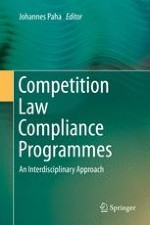2016 | OriginalPaper | Chapter
9. Can Compliance Programmes Contribute to Effective Antitrust Enforcement?
Author : Florence Thépot
Published in: Competition Law Compliance Programmes
Publisher: Springer International Publishing
Activate our intelligent search to find suitable subject content or patents.
Select sections of text to find matching patents with Artificial Intelligence. powered by
Select sections of text to find additional relevant content using AI-assisted search. powered by
